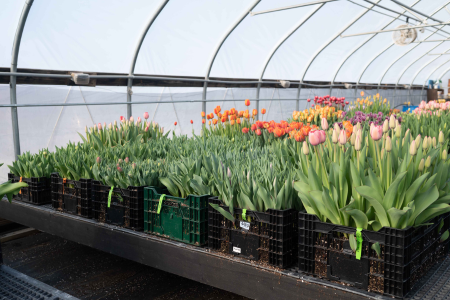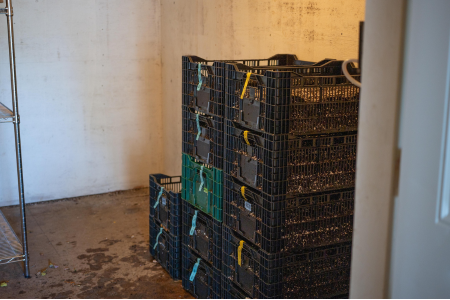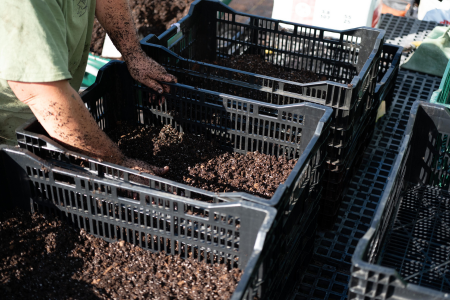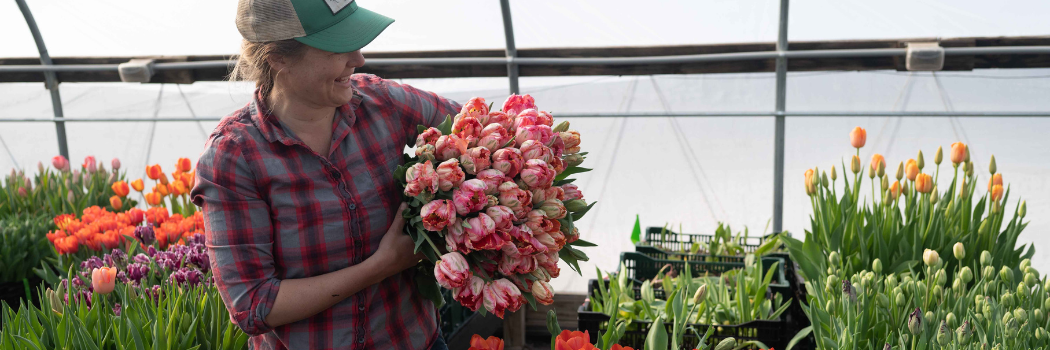- Tulip (Tulipa) Bulb Varieties | Comparison Chart (PDF)
- Tulip (Tulipa spp) | Key Growing Information
- Tulip & Narcissus Production Guide | Tech Sheet (PDF)
- Video: Overwintering Tulips in an Unheated Tunnel
- 'Finola' Double Late Flowering Tulip
- Video: 'Queensday' Tulip | from Johnny's Selected Seeds
- Tulip Harvesting: Tips & Recommendations
- 'Drumline' Double Late Flowering Tulip
- Video: 'Marie Jo' Tulip from Johnny's Selected Seeds
- 'Sensual Touch' Double Late Flowering Tulip
- 'Queen of the Night' Single Late Tulip
- 'Amazing Parrot' Apricot-Colored Parrot Tulip
- 'Dream Touch' Double Late Flowering Tulip
- 'Sunset Tropical' Double Late Flowering Tulip
- 'Astronaut Andre Kuipers' Tulip
- 'Foxtrot' Fragrant Double-Late-Flowering Tulip
- 'Marit' Darwin Hybrid Single Tulip
- 'Charming Beauty' Double Late Flowering Tulip
- 'Parrot King' Tulip
- 'Apricot Parrot' Tulip
- Video: 'Margarita' Tulip from Johnny's Selected Seeds
- Video: Darwin Hybrid Tulips from Johnny's Selected Seeds
- Video: 'Exotic Emperor' Tulip | from Johnny's Selected Seeds
- 'Verona' Double Early Flowering Tulip
- 'Menton' Single Late-Flowering Tulip
- 'Silver Cloud' Triumph Tulip
- 'Black Parrot' Late-Flowering Parrot Tulip
- 'Crème Upstar' Double Late Flowering Tulip
- Cut-Flower Harvesting & Post-Harvest Care | Best Practices from Pros in the Slow Flower Community
- Chrysal Clear Bulb Flower Conditioner | SDS
- Chrysal Clear Bulb T-Bag | Cut-Flower Conditioner | SDS
- Calculator - Bloom Date & Chilling Date for Forced Tulips | Johnny's Selected Seeds
- Introduction to Forcing Flower Bulbs in Soil | Guide to Forcing Flower Bulbs
- 'Mondial' Tulip from Johnny's Selected Seeds
- Forcing Tulip Bulbs | Guide to Forcing Flower Bulbs
- 'Dordogne' Tulip from Johnny's Selected Seeds
- Choosing Tulip Varieties for Forcing | Guide to Forcing Flower Bulbs
- Planting Tulip & Narcissus Bulbs at the Johnny's Research Farm
Introduction to Forcing Flower Bulbs in Soil
By Joy Longfellow, Flower Trial Technician
Flower bulbs in bloom are a welcome sign of spring the world over. Traditionally planted in the fall, bulbs such as tulips, daffodils, muscari, and hyacinth bloom in the spring in beautiful displays of color. Many bulb crops can be brought to flower earlier (or later) than they would flower in natural conditions by meeting specific growing conditions.
This process of bringing bulbs into bloom outside of their normal seasonal cycle is called forcing.
Why Force Bulbs?
Commercial cut-flower growers force bulbs to ensure blooms at times of high demand, to be first to market with spring blooms, or to target holiday sales. Forcing bulbs can be done on any scale—from a few bulbs for early spring flowers in your home, to thousands of bulbs for cut flower production. The information presented here focuses on conditions for producing blooms for cut flower production on a commercial scale. If you intend to force bulbs on a smaller scale, the same general principles apply.

The Process of Forcing Bulbs
Spring-flowering bulbs such as tulips and narcissus require a chilling period to achieve high-quality blooms on long stems. The bulbs are normally planted in the fall. In northern climates they experience several weeks of moderate autumn temperatures, allowing bulbs to establish a strong root network before the ground freezes. Winter temperatures provide adequate chilling. When snow melts in the spring and the soil warms, shoots elongate and bulbs flower once they have received sufficient warmth and light.
In a forcing system, the goal is to provide all the conditions needed for flowering, but on a different timeframe than nature provides.
To achieve earlier bloom times, growers make use of a climate-controlled environment to start the chilling period earlier than would occur in nature. A good forcing system will mimic the natural cycle as closely as possible, providing time for the bulbs to:
- develop a good root system
- receive appropriate chilling time
- experience the warmth and light needed to stimulate growth and flowering
The specific requirements for forcing will vary depending on species and variety, but the general process of forcing flower bulbs can be summarized as follows:
- Plant bulbs in bulb crates or other suitable, moveable containers.
- Hold bulbs at a temperature suitable for root development.
- Once roots are established, reduce the temperature and hold bulbs for continued chilling.
- Once the chilling requirement has been met, move the bulbs to a heated greenhouse for flowering.
Infrastructure Needed for Forcing

For successful bulb forcing, you will need the following:
Rooting Space
A cool, dark space where temperatures range between 40–50°F and bulbs are protected from rodents. A basement, garage, or CoolBot® could work. We use either a CoolBot set to 48°F, or a dark, unheated storage space that ranges from 40–50°F during the fall months.Chilling Space
A climate-controlled dark space where temperatures can be held near freezing. We use a CoolBot set to 34°F.Housing Space
A greenhouse for growing on the bulbs to flowering, heated to 60°F. You will need access to water in this space so that you can irrigate the bulbs as they are growing on.
Materials Needed for Forcing Bulbs in Soil

While it is possible to force bulbs hydroponically, without soil or other growing media, the information presented here is for those forcing in crates, using soil or other growing media. Here are the materials you will need:
Crates
- Bulb crates work well for this. There are generally two heights of bulb crates available. While the shorter crates allow for more crates to be stacked in whatever space is being used, the taller crates “deep crates” provide a little more depth. It’s likely that your bulbs will start to emerge from the soil before they come out of cold storage. Deeper crates allow more space for shoot emergence. Either will work; they each provide a slightly different benefit.
- Planted crates are heavy. If possible, think through your system to minimize the number of times you must move crates.
Soil
- We use Pro-Mix, a sterile peat-based potting mix.
- In general, soil mixes should be disease-free, allow for good drainage and have a pH between 5.5–6.5 (Miller 2010). If you are steaming or otherwise heat-sterilizing your soil mix, make sure that is has cooled to 55°F or lower before planting bulbs into the mix.
Water
- Crates will need to be heavily watered after planting.
Flower Bulbs
- Depending on the size of the bulbs, 60–70 bulbs will usually fit comfortably in a crate.
Next up: read Forcing Tulip Bulbs for detailed instructions on forcing Tulip bulbs, along with trial results from our research farm.


